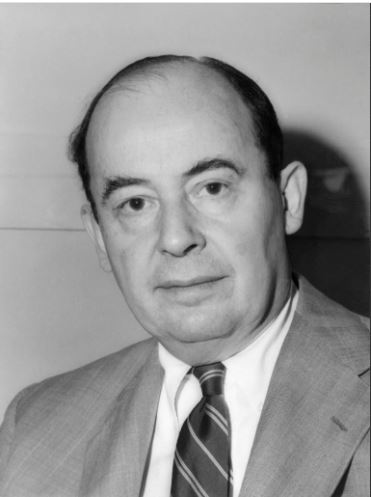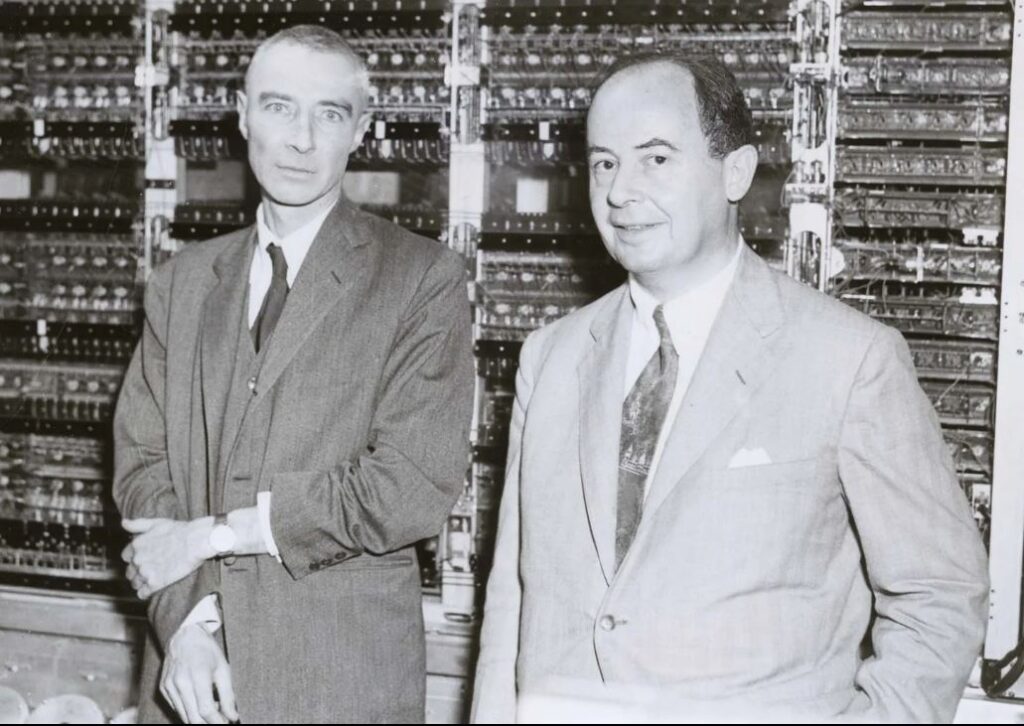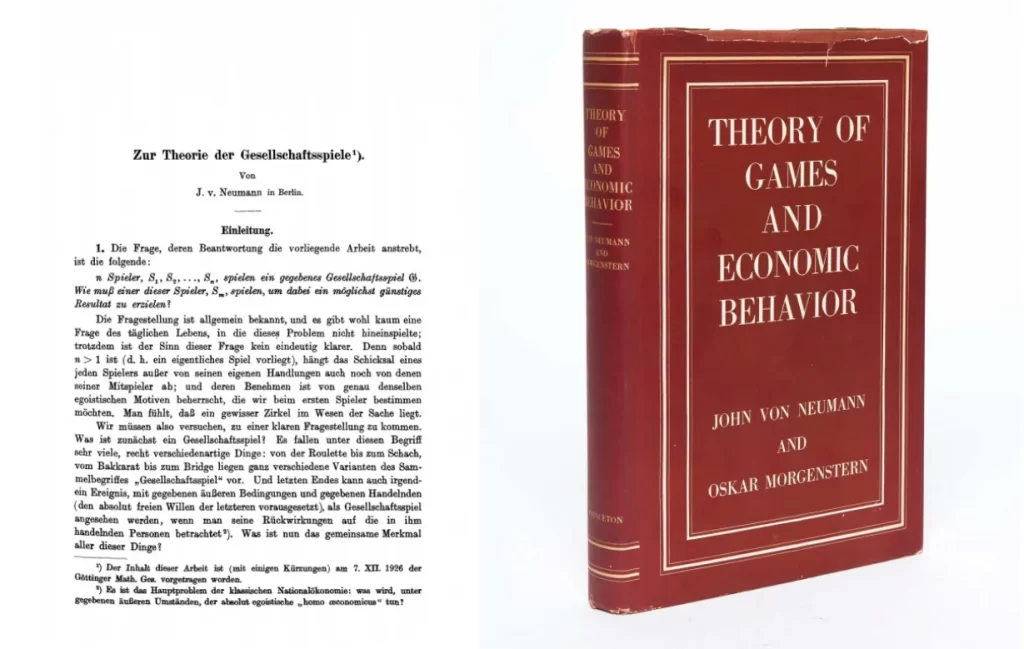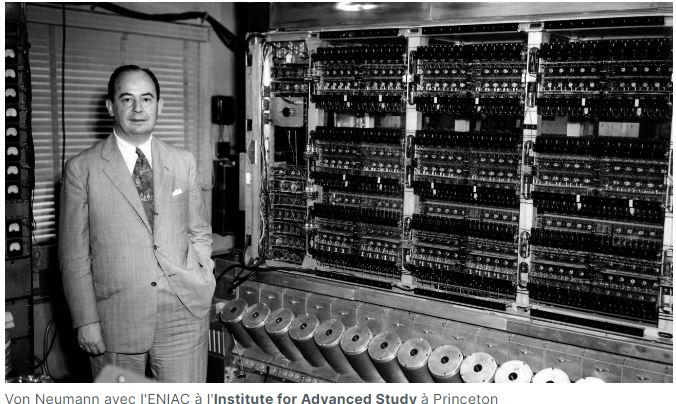(1903-1957) was a Hungarian-American mathematician, physicist, computer scientist, and polymath who made pioneering contributions to a wide range of fields, including mathematics, physics, economics, and computer science. In the context of Computational Fluid Dynamics (CFD), von Neumann made significant contributions to the development of numerical methods for solving complex fluid flow problems.
One of von Neumann’s key contributions to CFD was his work on the development of the Monte Carlo method, a computational technique used to solve a wide range of mathematical problems by simulating random sampling. This method has been widely used in CFD simulations to solve complex fluid flow problems with stochastic elements.
Von Neumann also played a key role in the development of early computers and computing techniques. He was a key figure in the development of the ENIAC (Electronic Numerical Integrator and Computer), one of the first electronic general-purpose computers, and later the MANIAC (Mathematical Analyzer, Numerical Integrator, and Computer). His work in computer science laid the foundation for the use of computers in CFD and other scientific disciplines.
Overall, von Neumann’s contributions to CFD and computational science more broadly have had a lasting impact on the field, helping to pave the way for the development of modern computational techniques used in fluid dynamics and other scientific disciplines.
John von Neumann was instrumental in the development of numerical analysis and computing, both of which are foundational to modern Computational Fluid Dynamics (CFD). Here are some more details about his contributions to the field:
- Numerical Analysis: Von Neumann made significant contributions to numerical analysis, which is the study of algorithms for solving numerical problems. His work laid the groundwork for many numerical methods used in CFD, such as finite difference, finite volume, and finite element methods. These methods are essential for solving the partial differential equations that govern fluid flow in CFD simulations.
- Von Neumann Stability Analysis: Von Neumann developed the concept of stability analysis for numerical methods. This analysis is crucial for determining whether a numerical method will produce accurate and reliable results. In CFD, stability analysis is used to ensure that numerical simulations remain stable and do not produce unphysical results.
- Computing: Von Neumann was a key figure in the development of early computers and computing techniques. He played a central role in the design and construction of the ENIAC, one of the first electronic computers. His work on computer architecture and programming languages laid the foundation for modern computing and the use of computers in CFD simulations.
- Contributions to Fluid Dynamics: While von Neumann’s primary contributions were in numerical analysis and computing, his work had a significant impact on the field of fluid dynamics. His methods and techniques have been applied to a wide range of fluid flow problems, from aerodynamics to weather forecasting.
Overall, John von Neumann’s work laid the foundation for modern CFD by developing numerical methods, stability analysis techniques, and computer technologies that are essential for simulating fluid flow in a wide range of applications.
Early life and education
Von Neumann grew up in an affluent, highly assimilated Jewish family. His father, Miksa Neumann (Max Neumann), was a banker, and his mother, born Margit Kann (Margaret Kann), came from a family that had prospered selling farm equipment. Von Neumann showed signs of genius in early childhood: he could joke in Classical Greek and, for a family stunt, he could quickly memorize a page from a telephone book and recite its numbers and addresses. Von Neumann learned languages and math from tutors and attended Budapest’s most prestigious secondary school, the Lutheran Gymnasium. The Neumann family fled Béla Kun’s short-lived communist regime in 1919 for a brief and relatively comfortable exile split between Vienna and the Adriatic resort of Abbazia (now Opatija, Croatia). Upon completion of von Neumann’s secondary schooling in 1921, his father discouraged him from pursuing a career in mathematics, fearing that there was not enough money in the field. As a compromise, von Neumann simultaneously studied chemistry and mathematics. He earned a degree in chemical engineering (1925) from the Swiss Federal Institute in Zürich and a doctorate in mathematics (1926) from the University of Budapest.
European career, 1921–30
Von Neumann commenced his intellectual career at a time when the influence of David Hilbert and his program of establishing axiomatic foundations for mathematics was at a peak. A paper von Neumann wrote while still at the Lutheran Gymnasium (“The Introduction of Transfinite Ordinals,” published 1923) supplied the now-conventional definition of an ordinal number as the set of all smaller ordinal numbers. This neatly avoids some of the complications raised by Georg Cantor’s transfinite numbers. Von Neumann’s “An Axiomatization of Set Theory” (1925) commanded the attention of Hilbert himself. From 1926 to 1927 von Neumann did postdoctoral work under Hilbert at the University of Göttingen. The goal of axiomatizing mathematics was defeated by Kurt Gödel’s incompleteness theorems, a barrier that was understood immediately by Hilbert and von Neumann. (See also mathematics, foundations of: Gödel.)
Von Neumann took positions as a Privatdozent (“private lecturer”) at the Universities of Berlin (1927–29) and Hamburg (1929–30). The work with Hilbert culminated in von Neumann’s book The Mathematical Foundations of Quantum Mechanics (1932), in which quantum states are treated as vectors in a Hilbert space. This mathematical synthesis reconciled the seemingly contradictory quantum mechanical formulations of Erwin Schrödinger and Werner Heisenberg. Von Neumann also claimed to prove that deterministic “hidden variables” cannot underlie quantum phenomena. This influential result pleased Niels Bohr and Heisenberg and played a strong role in convincing physicists to accept the indeterminacy of quantum theory. In contrast, the result dismayed Albert Einstein, who refused to abandon his belief in determinism. (Ironically, Irish-born physicist John Stewart Bell demonstrated in the mid-1960s that von Neumann’s proof was flawed; Bell then fixed the proof’s shortcomings, reaffirming von Neumann’s conclusion that hidden variables were unnecessary. See also quantum mechanics: Hidden variables.)
By his mid-twenties, von Neumann found himself pointed out as a wunderkind at conferences. (He claimed that mathematical powers start to decline at age 26, after which experience can conceal the deterioration for a time.) Von Neumann produced a staggering succession of pivotal papers in logic, set theory, group theory, ergodic theory, and operator theory. Herman Goldstine and Eugene Wigner noted that, of all the principal branches of mathematics, it was only in topology and number theory that von Neumann failed to make an important contribution.
In 1928 von Neumann published “Theory of Parlor Games,” a key paper in the field of game theory. The nominal inspiration was the game of poker. Game theory focuses on the element of bluffing, a feature distinct from the pure logic of chess or the probability theory of roulette. Though von Neumann knew of the earlier work of the French mathematician Émile Borel, he gave the subject mathematical substance by proving the mini-max theorem. This asserts that for every finite, two-person zero-sum game, there is a rational outcome in the sense that two perfectly logical adversaries can arrive at a mutual choice of game strategies, confident that they could not expect to do better by choosing another strategy. (See also game theory: The von Neumann–Morgenstern theory.) In games like poker, the optimal strategy incorporates a chance element. Poker players must bluff occasionally—and unpredictably—in order to avoid exploitation by a savvier player.
Princeton, 1930–42
In 1929 von Neumann was asked to lecture on quantum theory at Princeton University. This led to an appointment as visiting professor (1930–33). He was remembered as a mediocre teacher, prone to write quickly and erase the blackboard before students could copy what he had written.
In 1930 von Neumann married Mariette Koevesi. They had one child, Marina, who later gained prominence as an economist. In 1933 von Neumann became one of the first professors at the Institute for Advanced Study (IAS), Princeton, New Jersey. The same year, Adolf Hitler came to power in Germany, and von Neumann relinquished his German academic posts. In a much-quoted comment on the Nazi regime, von Neumann wrote, “If these boys continue for only two more years…they will ruin German science for a generation—at least.”
Von Neumann’s first marriage ended in a divorce after Mariette fell in love with physicist Horner Kuper. Their 1937 separation was amicable and provided for Marina to spend her teenage years with her father. Von Neumann promptly rekindled ties with a childhood sweetheart, Klara Dan, who was herself married to someone else. Dan divorced her husband and married von Neumann in 1938. This second marriage lasted to the end of von Neumann’s life, though the couple’s letters betray a near-continuous history of quarrels and perceived slights. Klara was an intelligent woman who shared many of her husband’s interests and took jobs programming computers.
Motivated by a continuing desire to develop mathematical techniques suited to quantum phenomena, von Neumann introduced a theory of rings of operators, now known as von Neumann algebras (1929 through the 1940s). Other achievements include a proof of the quasi-ergodic hypothesis (1932) and important work in lattice theory (1935–37). It was not only the new physics that commanded von Neumann’s attention. A 1932 Princeton lecture, “On Certain Equations of Economics and a Generalization of Brouwer’s Fixed Point Theorem” (published 1937), was a seminal contribution to linear and nonlinear programming in economics. “Almost Periodic Functions and Groups” (1934–35) was awarded the American Mathematical Society’s Bôcher Prize in 1938.
Though no longer a teacher, von Neumann became a Princeton legend. It was said that he played practical jokes on Einstein, could recite verbatim books that he had read years earlier, and could edit assembly-language computer code in his head. Von Neumann’s natural diplomacy helped him move easily among Princeton’s intelligentsia, where he often adopted a tactful modesty. He once said he felt he had not lived up to all that had been expected of him. Never much like the stereotypical mathematician, he was known as a wit, bon vivant, and aggressive driver—his frequent auto accidents led to one Princeton intersection being dubbed “von Neumann corner.”
World War II
In late 1943 von Neumann began work on the Manhattan Project at the invitation of J. Robert Oppenheimer. Von Neumann was an expert in the nonlinear physics of hydrodynamics and shock waves, an expertise that he had already applied to chemical explosives in the British war effort. At Los Alamos, New Mexico, von Neumann worked on Seth Neddermeyer’s implosion design for an atomic bomb. This called for a hollow sphere containing fissionable plutonium to be symmetrically imploded in order to drive the plutonium into a critical mass at the centre. The implosion had to be so symmetrical that it was compared to crushing a beer can without splattering any beer. Adapting an idea proposed by James Tuck, von Neumann calculated that a “lens” of faster- and slower-burning chemical explosives could achieve the needed degree of symmetry. The Fat Man atomic bomb, dropped on the Japanese port of Nagasaki, used this design. Von Neumann participated in the selection of a Japanese target, arguing against bombing the Imperial Palace, Tokyo.
Overlapping with this work was von Neumann’s magnum opus of applied math, Theory of Games and Economic Behavior (1944), cowritten with Princeton economist Oskar Morgenstern. Game theory had been orphaned since the 1928 publication of “Theory of Parlor Games,” with neither von Neumann nor anyone else significantly developing it. The collaboration with Morgernstern burgeoned to 641 pages, the authors arguing for game theory as the “Newtonian science” underlying economic decisions. The book created a vogue for game theory among economists that has partly subsided. The theory has also had broad influence in fields ranging from evolutionary biology to defense planning.
Later years and assessment
In the postwar years, von Neumann spent increasing time as a consultant to government and industry. Starting in 1944, he contributed important ideas to the U.S. Army’s hard-wired ENIAC computer, designed by J. Presper Eckert, Jr., and John W. Mauchly. Most important, von Neumann modified ENIAC to run as a stored-program machine. He then lobbied to build an improved computer at the Institute for Advanced Study. The IAS machine, which began operating in 1951, used binary arithmetic—ENIAC had used decimal numbers—and shared the same memory for code and data, a design that greatly facilitated the “conditional loops” at the heart of all subsequent coding. Von Neumann’s publications on computer design (1945–51) created friction with Eckert and Mauchly, who sought to patent their contributions, and led to the independent construction of similar machines around the world. This established the merit of a single-processor, stored-program computer—the widespread architecture now known as a von Neumann machine. See also computer: Von Neumann’s “Preliminary Discussion” and BTW: Computer patent wars.
Another important consultancy was at the RAND Corporation, a think tank charged with planning nuclear strategy for the U.S. Air Force. Von Neumann insisted on the value of game-theoretic thinking in defense policy. He supported development of the hydrogen bomb and was reported to have advocated a preventive nuclear strike to destroy the Soviet Union’s nascent nuclear capability circa 1950. Despite his hawkish stance, von Neumann defended Oppenheimer against attacks on his patriotism and warned Edward Teller that his Livermore Laboratory (now the Lawrence Livermore National Laboratory) cofounders were “too reactionary.” From 1954 until 1956, von Neumann served as a member of the Atomic Energy Commission and was an architect of the policy of nuclear deterrence developed by President Dwight D. Eisenhower’s administration.
In his last years, von Neumann puzzled over the question of whether a machine could reproduce itself. Using an abstract model (a cellular automata), von Neumann outlined how a machine could reproduce itself from simple components. Key to this demonstration is that the machine reads its own “genetic” code, interpreting it first as instructions for constructing the machine exclusive of the code and second as data. In the second phase, the machine copies its code in order to create a completely “fertile” new machine. Conceptually, this work anticipated later discoveries in genetics.
Von Neumann was diagnosed with bone cancer in 1955. He continued to work even as his health deteriorated rapidly. In 1956 he received the Enrico Fermi Award. A lifelong agnostic, shortly before his death he converted to Roman Catholicism.
Economist Paul Samuelson judged von Neumann “a genius (if that 18th century word still has a meaning)—a man so smart he saw through himself.” Von Neumann was part of a serial exodus of Hungarians who fled to Germany and then to America, forging remarkable careers in the sciences. His friend Stanislaw Ulam recalled von Neumann attributing this Hungarian phenomenon to “a subconscious feeling of extreme insecurity in individuals, and the necessity of producing the unusual or facing extinction.” Von Neumann’s shift to applied mathematics after the midpoint of his career mystified colleagues, who felt that a genius of his calibre should concern himself with “pure” mathematics. In an essay written for James Newman’s The World of Mathematics (1956), von Neumann made an eloquent defense of applied mathematics. He praised the invigorating influence of “some underlying empirical, worldly motif” in mathematics, warning that “at a great distance from its empirical source, or after much abstract inbreeding, a mathematical subject is in danger of degeneration.” With his pivotal work on quantum theory, the atomic bomb, and the computer, von Neumann likely exerted a greater influence on the modern world than any other mathematician of the 20th century.




